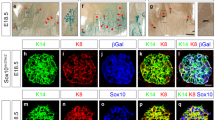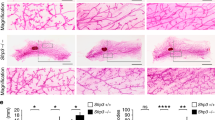Abstract
Branching morphogenesis within the peripubertal mouse mammary gland is directed by progesterone (P). A role for the homeobox-containing transcription factor, Msx2, during branching morphogenesis is suggested from its ontogenic expression profile and hormonal regulation. Herein, we define the spatio-temporal control of Msx2 expression, the regulation of its expression by P and its direct role in ductal branching morphogenesis. P induces Msx2 in the presence of estrogen (E) both in vitro and in vivo while absence of the P receptor (PR) decreased Msx2 expression. Stable transfection of PR into mouse mammary epithelial cells increased the endogenous expression of Msx2 and their ability to undergo branching morphogenesis in vitro. Furthermore, normal mammary cells stably-transfected with Msx2 demonstrated increased branching morphogenesis in vitro while transgenic mice expressing Msx2 in their mammary glands demonstrated enhanced lateral branching during early development. The action of P on branching morphogenesis appears to involve Bmp2/4. Together, these data demonstrate that P, acting through PR-A and the Bmp2/4 pathway, induces Msx2 to enhance ductal branching in the mammary glands.
This is a preview of subscription content, access via your institution
Access options
Subscribe to this journal
Receive 50 print issues and online access
$259.00 per year
only $5.18 per issue
Buy this article
- Purchase on Springer Link
- Instant access to full article PDF
Prices may be subject to local taxes which are calculated during checkout







Similar content being viewed by others
References
Abate-Shen C . (2002). Deregulated homeobox gene expression in cancer: cause or consequence? Nat Rev Cancer 2: 777–785.
Alappat S, Zhang ZY, Chen YP . (2003). Msx homeobox gene family and craniofacial development. Cell Res 13: 429–442.
Atwood CS, Hovey RC, Glover JP, Chepko G, Ginsburg E, Robison WG et al. (2000). Progesterone induces side-branching of the ductal epithelium in the mammary glands of peripubertal mice. J Endocrinol 167: 39–52.
Aupperlee MD, Smith KT, Kariagina A, Haslam SZ . (2005). Progesterone receptor isoforms A and B: temporal and spatial differences in expression during murine mammary gland development. Endocrinology 146: 3577–3588.
Bamberger AM, Bamberger CM, Gellersen B, Schulte HM . (1996). Modulation of AP-1 activity by the human progesterone receptor in endometrial adenocarcinoma cells. Proc Natl Acad Sci USA 93: 6169–6174.
Brisken C, Heineman A, Chavarria T, Elenbaas B, Tan J, Dey SK et al. (2000). Essential function of Wnt-4 in mammary gland development downstream of progesterone signaling. Genes Dev 14: 650–654.
Capecchi MR . (1997). Hox genes and mammalian development. Cold Spring Harb Symp Quant Biol 62: 273–281.
Chen H, Sukumar S . (2003). Role of homeobox genes in normal mammary gland development and breast tumorigenesis. J Mammary Gland Biol Neoplasia 8: 159–175.
Daniel CW, Smith GH . (1999). The mammary gland: a model for development. J Mammary Gland Biol Neoplasia 4: 3–8.
Davidson D . (1995). The function and evolution of Msx genes, pointers and paradoxes. Trends Genet 11: 405–411.
Fernandez-Valdivia R, Mukherjee A, Mulac-Jericevic B, Conneely OM, DeMayo FJ, Amato P et al. (2005). Revealing progesterone's role in uterine and mammary gland biology: insights from the mouse. Semin Reprod Med 23: 22–37.
Friedmann Y, Daniel CW . (1996). Regulated expression of homeobox genes Msx-1 and Msx-2 in mouse mammary gland development suggests a role in hormone action and epithelial-stromal interactions. Dev Biol 177: 347–355.
Gupta IR, Macias-Silva M, Kim S, Zhou X, Piscione TD, Whiteside C et al. (2000). BMP-2/ALK3 and HGF signal in parallel to regulate renal collecting duct morphogenesis. J Cell Sci 113: 269–278.
Haslam SZ . (1988). Acquisition of estrogen-dependent progesterone receptors by normal mouse mammary gland. Ontogeny of mammary progesterone receptors. J Steroid Biochem 31: 9–13.
Hovey RC, Trott JF, Ginsburg E, Goldhar A, Sasaki MM, Fountain SJ et al. (2001). Transcriptional and spatiotemporal regulation of prolactin receptor mRNA and cooperativity with progesterone receptor function during ductal branch growth in the mammary gland. Dev Dyn 222: 192–205.
Hovey RC, Trott JF, Vonderhaar BK . (2002). Establishing a framework for the functional mammary gland: from endocrinology to morphology. J Mammary Gland Biol Neoplasia 7: 17–38.
Ismail PM, Li J, DeMayo FJ, O’Malley BW, Lydon JP . (2002). A novel LacZ reporter mouse reveals complex regulation of the progesterone receptor promoter during mammary gland development. Mol Endocrinol 16: 2475–2489.
Kelly PA, Bachelot A, Kedzia C, Hennighausen L, Ormandy CJ, Kopchick JJ et al. (2002). The role of prolactin and growth hormone in mammary gland development. Mol Cell Endocrinol 197: 127–131.
Lanari C, Luthy I, Lamb CA, Fabris V, Pagano E, Helguero LA et al. (2001). Five novel hormone-responsive cell lines derived from murine mammary ductal carcinomas: in vivo and in vitro effects of estrogens and progestins. Cancer Res 61: 293–302.
Lee S, Mohsin SK, Mao S, Hilsenbeck SG, Medina D, Allred DC . (2006). Hormones, receptors, and growth in hyperplastic enlarged lobular units: early potential precursors of breast cancer. Breast Cancer Res 8: R6.
Lewis MT . (2000). Homeobox genes in mammary gland development and neoplasia. Breast Cancer Res 2: 158–169.
Lydon JP, DeMayo FJ, Conneely OM, O’Malley BW . (1996). Reproductive phenotypes of the progesterone receptor null mutant mouse. J Steroid Biochem Mol Biol 56: 67–77.
Malewski T, Milewicz T, Krzysiek J, Gregoraszczuk EL, Augustowska K . (2005). Regulation of Msx2 gene expression by steroid hormones in human nonmalignant and malignant breast cancer explants cultured in vitro. Cancer Invest 23: 222–228.
Mote PA, Bartow S, Tran N, Clarke CL . (2002). Loss of co-ordinate expression of progesterone receptors A and B is an early event in breast carcinogenesis. Breast Cancer Res Treat 72: 163–172.
Mulac-Jericevic B, Lydon JP, DeMayo FJ, Conneely OM . (2003). Defective mammary gland morphogenesis in mice lacking the progesterone receptor B isoform. Proc Natl Acad Sci USA 100: 9744–9749.
Nusse R . (2001). Developmental biology. Making head or tail of Dickkopf. Nature 411: 255–256.
Phippard DJ, Weber-Hall SJ, Sharpe PT, Naylor MS, Jayatalake H, Maas R et al. (1996). Regulation of Msx-1, Msx-2, Bmp-2 and Bmp-4 during foetal and postnatal mammary gland development. Development 122: 2729–2737.
Richer JK, Jacobsen BM, Manning NG, Abel MG, Wolf DM, Horwitz KB . (2002). Differential gene regulation by the two progesterone receptor isoforms in human breast cancer cells. J Biol Chem 277: 5209–5218.
Ruan W, Monaco ME, Kleinberg DL . (2005). Progesterone stimulates mammary gland ductal morphogenesis by synergizing with and enhancing insulin-like growth factor-I action. Endocrinology 146: 1170–1178.
Satoh K, Ginsburg E, Vonderhaar BK . (2004). Msx-1 and Msx-2 in mammary gland development. J Mammary Gland Biol Neoplasia 9: 195–205.
Satokata I, Ma L, Ohshima H, Bei M, Woo I, Nishizawa K et al. (2000). Msx2 deficiency in mice causes pleiotropic defects in bone growth and ectodermal organ formation. Nat Genet 24: 391–395.
Shyamala G, Yang X, Cardiff RD, Dale E . (2000). Impact of progesterone receptor on cell-fate decisions during mammary gland development. Proc Natl Acad Sci USA 97: 3044–3049.
Smith WC, Harland RM . (1992). Expression cloning of noggin, a new dorsalizing factor localized to the Spemann organizer in Xenopus embryos. Cell 70: 829–840.
Sunil N, Bennett JM, Haslam SZ . (2002). Hepatocyte growth factor is required for progestin-induced epithelial cell proliferation and alveolar-like morphogenesis in serum-free culture of normal mammary epithelial cells. Endocrinology 143: 2953–2960.
Wang W, Chen X, Xu H, Lufkin T . (1996). Msx3: a novel murine homologue of the Drosophila msh homeobox gene restricted to the dorsal embryonic central nervous system. Mech Dev 58: 203–215.
Wechselberger C, Ebert AD, Bianco C, Khan NI, Sun Y, Wallace-Jones B et al. (2001). Cripto-1 enhances migration and branching morphogenesis of mouse mammary epithelial cells. Exp Cell Res 266: 95–105.
Willert J, Epping M, Pollack JR, Brown PO, Nusse R . (2002). A transcriptional response to Wnt protein in human embryonic carcinoma cells. BMC Dev Biol 2: 8.
Zhang HZ, Bennett JM, Smith KT, Sunil N, Haslam SZ . (2002). Estrogen mediates mammary epithelial cell proliferation in serum-free culture indirectly via mammary stroma-derived hepatocyte growth factor. Endocrinology 143: 3427–3434.
Acknowledgements
We thank Dr Lionel Fiegenbaum of the NCI Frederick Cancer Research and Development Center for helping generate the MMTV-Msx2 transgenic mice. This research was supported by the Intramural Research Program of the NIH, Center for Cancer Research, NCI.
Author information
Authors and Affiliations
Corresponding author
Additional information
Supplementary Information accompanies the paper on the Oncogene website (http://www.nature.com/onc).
Supplementary information
Rights and permissions
About this article
Cite this article
Satoh, K., Hovey, R., Malewski, T. et al. Progesterone enhances branching morphogenesis in the mouse mammary gland by increased expression of Msx2. Oncogene 26, 7526–7534 (2007). https://doi.org/10.1038/sj.onc.1210555
Received:
Revised:
Accepted:
Published:
Issue Date:
DOI: https://doi.org/10.1038/sj.onc.1210555
Keywords
This article is cited by
-
Hormone Signaling Requirements for the Conversion of Non-Mammary Mouse Cells to Mammary Cell Fate(s) in Vivo
Journal of Mammary Gland Biology and Neoplasia (2015)
-
Amphiregulin mediates progesterone-induced mammary ductal development during puberty
Breast Cancer Research (2013)
-
Phosphorylated and sumoylation-deficient progesterone receptors drive proliferative gene signatures during breast cancer progression
Breast Cancer Research (2012)
-
Homeobox transcription factor muscle segment homeobox 2 (Msx2) correlates with good prognosis in breast cancer patients and induces apoptosis in vitro
Breast Cancer Research (2010)
-
RARα1 control of mammary gland ductal morphogenesis and wnt1-tumorigenesis
Breast Cancer Research (2010)



